Looking for a pair of running shoes?
By, C.H. Lim
Choosing a pair of good, and suitable running shoes, does not actually depends on the brand or the price of that particular shoes, it requires professional guides.
Here are some proper shoe fitting guide.
Do It Yourself:
Shoe Types
Neutral Cushioning Shoes
A Neutral Cushioning shoe is best for runners with a high arch who do not pronate effectively. These shoes do not have medial supports but are more concerned with midsole cushioning. The midsole will provide the extra shock absorption that the lack of pronation is missing. Along with a runner who does not overpronate, Neutral Cushioned shoes also work well for midfoot and forefoot strikers.
Motion Control Shoes
Motion Control shoes are for runners who generally have a low or flat arch and are moderate to severe overpronators. These shoes employ extra support devices on the medial side to slow excessive pronation and tend to have wider and flatter outsoles. Heavier runners who need extra support and durability may also want Motion Control shoes.
Stability Shoes
Stability shoes are for runners who have normal or medium arches who are mild to moderate overpronators. These shoes have some medial support and good midsole cushioning. Because normal or medium arches are the most common foot type, most runners will need Stability shoes.
Trail Shoes
A Trail shoe is for a runner who desires better traction and durability for off-road runs. These shoes tend to be more weather and water resistant and are slightly stiffer for better stability on uneven terrain. Trail shoes can be Stability, Motion Control or Neutral Cushioning depending on the model and are suited for different runners the same way road shoes are.
- Pour a layer of water into a shallow pan.
- Wet the bottom of your foot.
- Step onto a paper towel or any surface that will leave an imprint of your foot.
- Look at the imprint and match it to one of the arch types below.
Arch Types
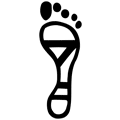 Figure 1. | Normal (medium) ArchA Normal or Medium Arch will leave an imprint of the heel and the forefoot connected by a wide band (See Figure 1.). After heel strike, this foot type will pronate or roll inward slightly to absorb shock. This is the most common foot type. This foot type is best suited for Stability shoes that use support devices such as dual density midsoles and medial posts for mild overpronation. | 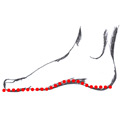 |
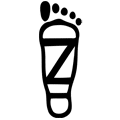 Figure 2. | Flat (low) ArchA Flat or Low Arch will leave an imprint of almost the entire bottom of the foot (See Figure 2.). This foot type is usually an indication of the excessive inward roll of the foot after heel strike commonly referred to as overpronation. The arch collapses too much which may cause overuse injuries. This foot type is best suited for Stability shoes and Motion Control shoes. These shoes have firmer medial support devices and flatter soles that are best for moderate to severe overpronators as well as heavier runners. | 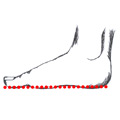 |
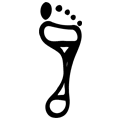 Figure 3. | High ArchA High-Arched Foot will show an imprint of the heel and the forefoot connected by only a thin band (See Figure 3.). This type of foot does not overpronate at all, so its not an effective shock absorber. This is the least common foot type. Lack of pronation is generally called supination or under-pronation. The High-Arched Foot is best suited for Neutral Cushioning shoes that do not have stability devices or a medial post. This type of shoe has a softer midsole and more flexibility that will not inhibit natural pronation. | 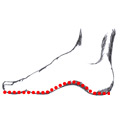 |
Shoe Types
Neutral Cushioning Shoes
A Neutral Cushioning shoe is best for runners with a high arch who do not pronate effectively. These shoes do not have medial supports but are more concerned with midsole cushioning. The midsole will provide the extra shock absorption that the lack of pronation is missing. Along with a runner who does not overpronate, Neutral Cushioned shoes also work well for midfoot and forefoot strikers.
Motion Control Shoes
Motion Control shoes are for runners who generally have a low or flat arch and are moderate to severe overpronators. These shoes employ extra support devices on the medial side to slow excessive pronation and tend to have wider and flatter outsoles. Heavier runners who need extra support and durability may also want Motion Control shoes.
Stability Shoes
Stability shoes are for runners who have normal or medium arches who are mild to moderate overpronators. These shoes have some medial support and good midsole cushioning. Because normal or medium arches are the most common foot type, most runners will need Stability shoes.
Trail Shoes
A Trail shoe is for a runner who desires better traction and durability for off-road runs. These shoes tend to be more weather and water resistant and are slightly stiffer for better stability on uneven terrain. Trail shoes can be Stability, Motion Control or Neutral Cushioning depending on the model and are suited for different runners the same way road shoes are.
Gait Types
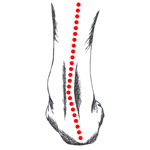 Right Foot | Severe Overpronation: The outside of the heel strikes the ground first and the foot rolls inward excessively which means the foot and ankle cannot properly stabilize the body. Shock is not efficiently absorbed when overpronation occurs. Additionally, due to overpronation, the big toe and second toe must do all the work at the end of the gait cycle during toe-off. The best shoes for moderate to severe Overpronators are Stability shoes or Motion Control shoes depending on the severity of overpronation. |
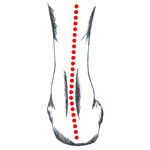 Right Foot | Mild Overpronation: The outside of the heel strikes the ground first and the foot rolls inward slightly absorbing the shock more effectively which allows the foot and ankle to properly support the body. The foot pronates, but not excessively. The foot pushes off evenly at the end of the gait cycle with mild pronation. Your ankles and feet maintain the vertical line of the lower leg. This is the most common foot type. The best shoes for Mild Overpronators are Stability shoes that have some medial posting. |
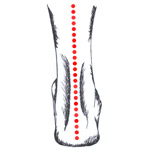 Right Foot | Neutral: The outside of the heel strikes the ground first and the foot rolls inward slightly absorbing the shock more effectively which allows the foot and ankle to properly support the body. The foot pronates, but not excessively. The foot pushes off evenly at the end of the gait cycle with mild pronation. Your ankles and feet maintain the vertical line of the lower leg. The best shoes for Neutral runners are Neutral Cushioning shoes for feet that are more rigid. |
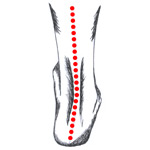 Right Foot | Supination: The outside of the heel strikes the ground first but the foot does not roll inward during the gait cycle. Instead it stays on the outside causing the impact to be concentrated on a smaller portion on the lateral side of the foot. This decreases shock absorption and causes the smaller toes to do most of the work during push-off. The best shoes for Supinators are more flexible Neutral Cushioning shoes with single-density midsoles. |
| To people who planned for a new shoes, all of these above are crucial to be concern in fact it not merelyt influence performances but also it might ensure safety. | ||||
| For further inquiries or details, please consult to specialists or professional. |








0 Response to "Looking for a pair of running shoes?"
Post a Comment